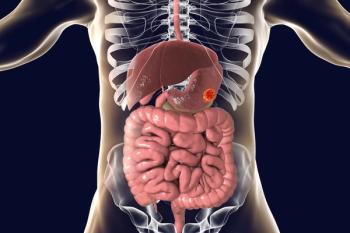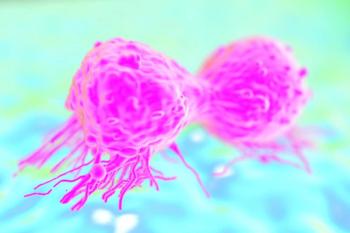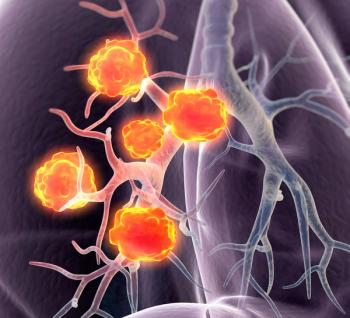
- ONCOLOGY Vol 11 No 3
- Volume 11
- Issue 3
Use of Predictors of Recurrence to Plan Therapy for DCIS of the Breast
The incidence of ductal carcinoma in situ (DCIS) has increased dramatically since the advent of screening mammography in the 1980s. The age-adjusted DCIS incidence rates increased 17.5% annually from 1983 to 1992.[1] The percentage of patients with DCIS treated with mastectomy has decreased from 71% in 1983 to 44% in 1992. The percentage of patients with DCIS undergoing lumpectomy and radiation in 1992 was 23.3% and lumpectomy only was 30.2%.
The incidence of ductal carcinoma in situ (DCIS) has increased dramaticallysince the advent of screening mammography in the 1980s. The age-adjustedDCIS incidence rates increased 17.5% annually from 1983 to 1992.[1] Thepercentage of patients with DCIS treated with mastectomy has decreasedfrom 71% in 1983 to 44% in 1992. The percentage of patients with DCIS undergoinglumpectomy and radiation in 1992 was 23.3% and lumpectomy only was 30.2%.
The clinical significance of DCIS detected by mammography is still uncertain.It is unclear which patients will ultimately develop invasive disease.Many investigators are concerned about the overdiagnosis and subsequentovertreatment of these cases. However, this concern must be balanced againstthe finding in one study of an actuarial local recurrence rate of 19% afterexcision and radiation therapy, with 53% of the recurrences presentingas invasive disease.[2] Therefore, it is certain that a significant percentageof DCIS lesions are obligate precursors to invasive disease and could potentiallyaffect the survival of the patient.
Different Classifications for DCIS
Drs. Silverstein and Lagios, in their thoughtful summary and discussion,present a tool to help predict local recurrence in patients with DCIS andtherefore recommend local treatment. It has long been recognized that DCISis not one homogeneous disease. Therefore, there have been various suggestionsfor new classifications of DCIS.
Poller et al suggested a simplified classification for DCIS based oncellular proliferation and c-erbB-2 protein expression.[3] This paper isthe basis for the current Van Nuys Pathologic Classification. The threecategories proposed by Poller et al were comedo DCIS, DCIS with necrosis(non-pure comedo), and DCIS without necrosis. The cases of comedo DCISand DCIS with necrosis were associated with a higher S-phase and the presenceof c-erb-B2 protein. The current Van Nuys classification identifies threefactors that are felt to be important in predicting local recurrence: tumorsize, pathologic margins, and a pathologic classification using nucleargrade and the presence or absence of necrosis.
Holland et al based their classification primarily on cytonuclear differentiationand secondarily on architectural differentiation.[4] These investigatorsdefined three categories. The first category consists of poorly differentiatedtumors with absent or minimal architectural differentiation and usuallywith necrosis present. The most important characteristic feature is themarked pleomorphic nuclei. The second category is well-differentiated DCIS,usually with a cribriform, micropapillary, changing, and rarely solid pattern.Necrosis is absent and mitoses are uncommon. The third group is intermediatelydifferentiated DCIS.
The strength of this classification is that cytonuclear features aremore often consistent in DCIS than is architectural pattern or necrosis.However, as yet there is no correlation between this classification andthe biologic activity of DCIS.
In a study by Bobrow et al, two independent observers used the Hollandclassification to reclassify 105 cases of DCIS.[5] The poorly differentiatedgroup was associated with c-erb-B2 protein staining, a high proliferationrate, p53 protein, and the absence of progesterone receptors. Well-differentiatedlesions had no c-erb-B2 or p53 present, proliferation was low in all cases,and progesterone receptors were present in 95%. These findings may helpdetermine the biology of DCIS and may be used in the future to determineappropriate treatments.
How to Define a Free Margin?
The specific prognostic factors used in the Van Nuys Prognostic Index(VNPI) include the measurement of tumor margins. When is a free marginfree? The answer is not so simple. Determination of negative pathologicmargins differs among groups reporting DCIS data. Solin et al defined negativemargins as tumor more than 2 mm from the inked margin.[2] Margins weredetermined by a retrospective review of patient records and were availablein only 47%. The NSABP defined negative margins as no transection of thetumor.[6] Of the 790 NSABP cases, 40% either were unavailable for centralpathologic review or had unknown margins.
In the Van Nuys series, all cases underwent central pathology reviewby one pathologist. In their initial publications, Silverstein et al didnot rigorously define free margins.[7,8] However, in a subsequent publication,the scoring system used an exact measurement of tumor-free areas, givingeach one a different score.[9] This includes, as a best-case scenario,a 10-mm or more margin.
The use of a 10-mm or more margin seems very logical based on the workof Holland's group. They reported on the results of a three-dimensionalimaging study of DCIS in 60 mastectomy specimens.[10] They found that continuousand multifocal growth patterns are usual, and that multicentric tumors(defined as a gap of 4 cm or more) are rare, occurring in only one case.Poorly differentiated tumors more often had continuous growth, whereaswell-differentiated lesions had multifocal distribution. Therefore, reliabilityof margin assessment varies with type. In all the cases reviewed, only8% had a multifocal distribution with gaps more than 10 mm and 7% werein well-differentiated tumors.
The conclusion that can be drawn from the work of Holland et al is that90% of all DCIS can be removed surgically if a 1-cm margin is attainable.Clearly, it is not always feasible to do this and obtain a good cosmeticresult.
Which Factors Predict Local Recurrence?
The next question is, if all DCIS is removed, which prognostic factorswill predict local recurrence? The Van Nuys group suggests that it is patientswith high-nuclear-grade lesions (grade 3) who are most likely to developa recurrence, followed by those with grade 1 or 2 lesions with necrosis.Their conclusion is based on a retrospective classification of patients,which, as the authors point out, are a highly selected group. The patientspresented in the Van Nuys series received one of two different nonrandomizedtreatments, either excision or excision followed by radiation therapy.The multivariate analysis for prognostic factors predictive of recurrencewas significant for nuclear grade, tumor size, and margin width, and showeda trend toward significance for the presence of necrosis.
The NSABP B-17 study reported that the presence of moderate or markedcomedo necrosis predicted for second ipsilateral breast tumors.[6] Solinet al found that no pathologic parameters were predictive of local failureafter radiation therapy.[2] Ottesen et al found that tumor size 10 mm,or more large nuclei, and comedo necrosis predicted for local recurrenceafter excision of DCIS.[11] These data would suggest that necrosis, indicativeof a high proliferative rate, and large nuclei with pleormorphism and prominentnucleoli are associated with more aggressive local disease.
Conclusions
In conclusion, DCIS is a very heterogeneous disease. This is no doubtthe reason for such controversy, disagreement, and uncertainty over itstreatment. The Van Nuys classification attempts to simplify treatment decisions.Intuitively, this classification and the treatment recommendations basedon it make good common sense. First, it is ideal to obtain clear marginsby 1 cm. If that is impossible, residual disease is likely, and thus, mastectomyis the only treatment available to remove all the disease. This still doesnot take into consideration the possibility that lesions may be biologically"benign" and not likely to progress to invasive disease. If thetumor is large, a good cosmetic result may not be likely with wide excision,and therefore, mastectomy may be appropriate. If the tumor is small withclear margins, excision alone may be adequate, except in high-grade cases.
There is still a question as to whether the local recurrence rate ishigher with high-grade cases compared to good nuclear grade. Treatmentoptions for high-nuclear grade lesions include radiation, with mastectomyreserved for the treatment of the local recurrence (since disease willnot recur in a significant number of women), or mastectomy as primary localtreatment. In any case, as Drs. Silverstein and Lagios state, patientsshould be informed of all the pros and cons of each treatment option.
The Van Nuys group appropriately points out that their data are retrospective.Patients were selected for a certain local treatment based on the factorsfelt to be important at that moment in time. Ideally, it is important totest various local treatments in a prospective randomized trial with attentionto such details as margins, nuclear grade, and necrosis.
There are many ongoing European trials evaluating radiation after segmentalmastectomy in a large number of women with DCIS.[12] Central pathologicreview of these studies could help clarify some of the unanswered questions.Future trial results, such as those of the NSABP and the United Kingdomtrial evaluating the use of tamoxifen (Nolvadex) in DCIS, are eagerly awaited.
The elucidation of the biology of different subsets of DCIS will goa long way toward clarifying treatment decisions. Also, prospective treatmentbased on biologic markers of proliferation and aggressiveness will helpdetermine the appropriate treatments.
References:
1. Ernster VL, Barclay J, Kerlikowske K, et al: Incidence of and treatmentfor ductal carcinoma in situ of the breast. JAMA 275:913-918, 1996.
2. Solin LJ, Kurtz J, Fourquet A, et al: Fifteen-year results of breast-conservingsurgery and definitive breast irradiation for the treatment of ductal carcinomain situ of the breast. J Clin Oncol 14:754-763, 1996.
3. Poller DN, Silverstein MJ, Galea M, et al: Ductal carcinoma in situof the breast: A proposal for a new simplified histological classificationassociation between cellular proliferation and c-erbB-2 protein expression.Mod Pathol 7(2):257-262, 1994.
4. Holland R, Peterse JL, Millis RR, et al: Ductal carcinoma in situ:A proposal for a new classification. Semin Diagn Pathol 11(3):167-180,1994.
5. Bobrow LG, Happerfield LC, Gregory WM, et al: The classificationof ductal carcinoma in situ and its association with biological markers.Semin Diagn Pathol 11(3):199-207, 1994.
6. Fisher ER, Costantino J, Fisher B, et al: Pathologic findings fromthe National Surgical Adjuvant Breast Project (NSABP) protocol B-17. Cancer75:1310-1319, 1995.
7. Silverstein MJ, Waisman JR, Gamagami P, et al: Intraductal carcinomaof the breast (208 cases): Clinical factors influencing treatment choice.Cancer 66:102-108, 1990.
8. Silverstein MJ, Poller DN, Waisman JR, et al: Prognostic classificationof breast ductal carcinoma in situ. Lancet 345:1154-1157, 1995.
9. Silverstein MJ, Lagios MD, Craig PH, et al: A prognostic index forductal carcinoma in situ of the breast. Cancer 77:2267-2274, 1996.
10. Faverly DRG, Burgers L, Bult P, et al: Three dimensional imagingof mammary ductal carcinoma in situ: Clinical implications. Semin DiagnPathol 11(3):193-198, 1994.
11. Ottesen GL, Graversen HP, Blichert-Toft M, et al: Ductal carcinomain situ of the female breast: Short-term results of a prospective nationwidestudy. Am J Surg Pathol 16(12):1183-1196, 1992.
12. van Dongen JA, Holland R, Peterse JL, et al: Ductal carcinoma insitu of the breast; second EORTC consensus meeting. Eur J Cancer 29(23)626-629,1992.
Articles in this issue
almost 29 years ago
AHCPR Releases Evidence Report on Colorectal Cancer Screeningalmost 29 years ago
Biologic Efficacy of Liarozole Confirmed in Metastatic Breast Canceralmost 29 years ago
DNA Data Could Spawn 'Genetic Underclass,' Says Va Physicianalmost 29 years ago
Apoptosis and Response to Radiation: Implications for Radiation Therapyalmost 29 years ago
Prostate Cancer: To Screen or Not to Screen?Newsletter
Stay up to date on recent advances in the multidisciplinary approach to cancer.

















































































